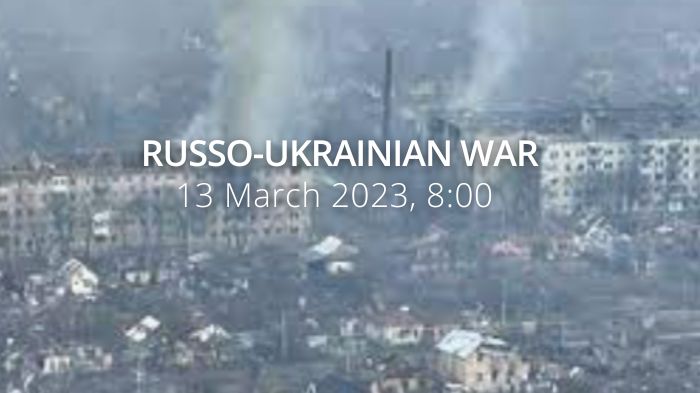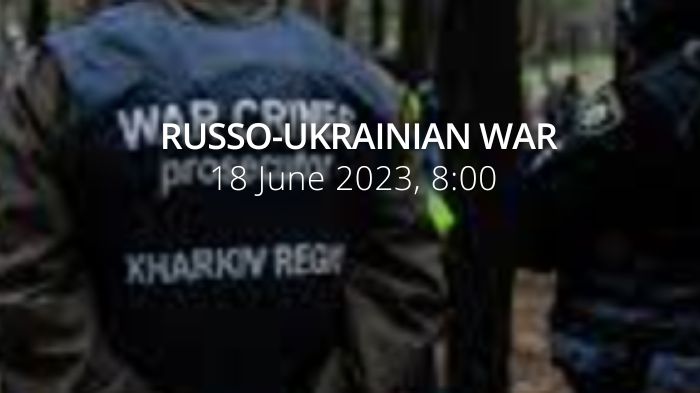#Odesa Mayor Trukhanov, #UNESCO Director-General Azoulay opened a memorial plaque dedicated to the inclusion of the historical center of Odesa in the UNESCO World Heritage List.
— Euromaidan Press (@EuromaidanPress) April 4, 2023
Overnight, Ukrainian air defense destroyed 14 out of 17 drones over the Odesa region. https://t.co/YWNaONjr1p
Daily overview — Summary report, April 5
A map of the approximate situation on the ground in Ukraine as of 00:00 UTC 05/04/23. pic.twitter.com/8Ocp1t7sMF
— War Mapper (@War_Mapper) April 5, 2023
The General Staff’s operational update regarding the Russian invasion as of 18.00 pm, April 5, 2023 is in the dropdown menu below:
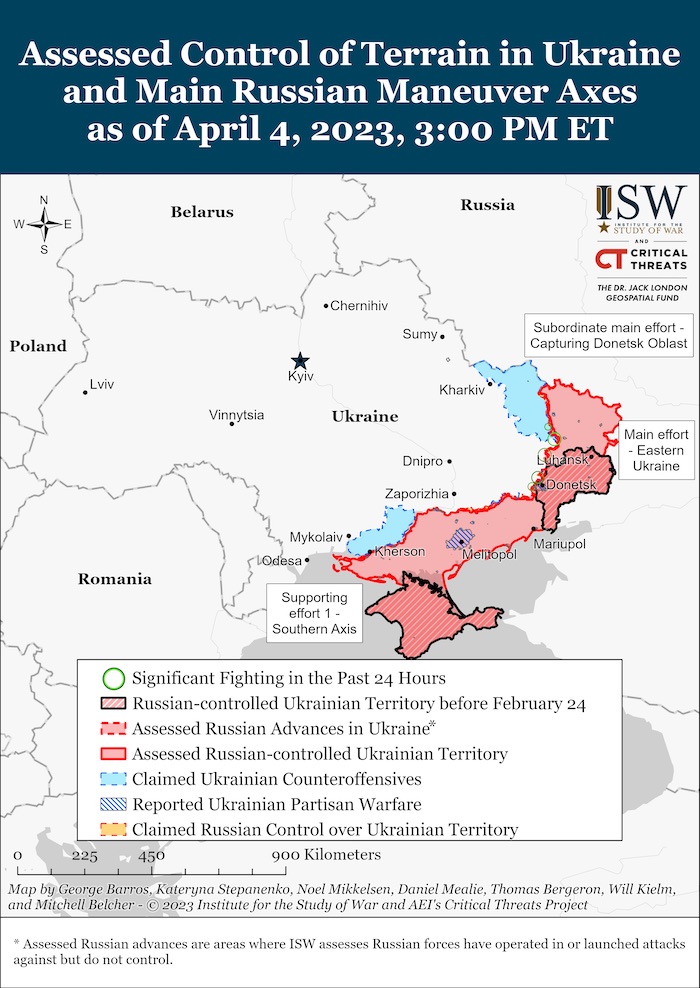
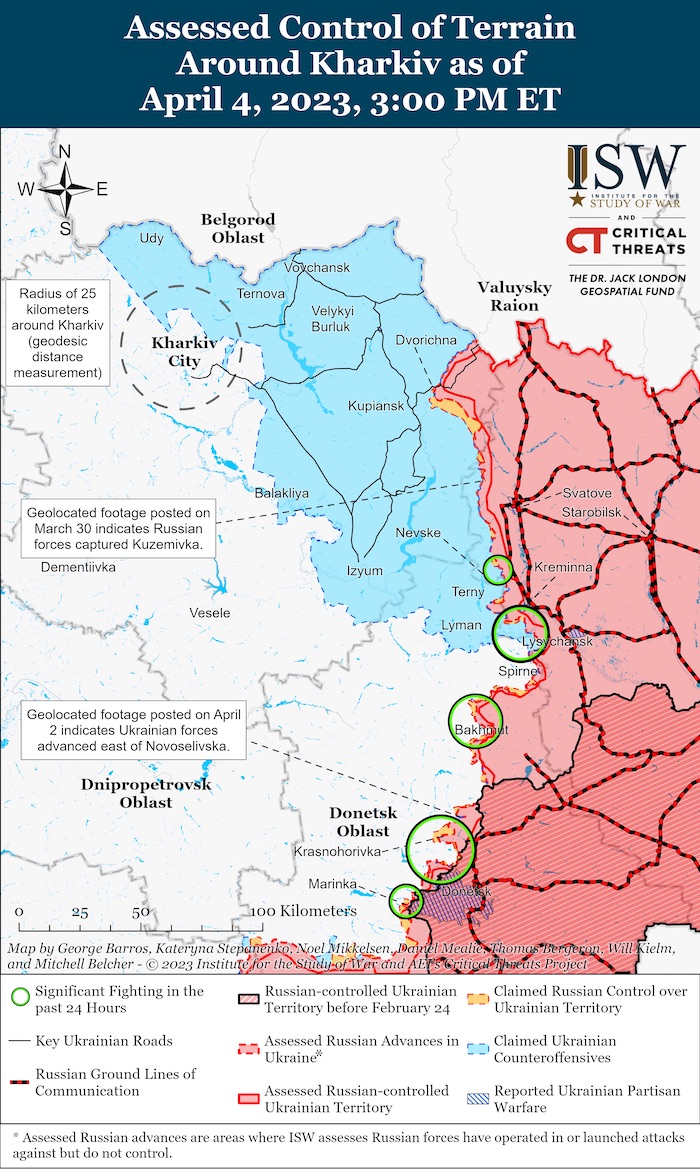
- Volyn’, Polissya, Sivershchyna and Slobozhanshchyna axes: the operational situation has not changed significantly; there are no signs of formations of enemy offensive groupings. Certain units of the Armed Forces of the Republic of Belarus continue to perform tasks in the areas bordering Ukraine. The Russian Federation will continue to use the airspace, territory, and military infrastructure of the Republic of Belarus. Russian maintains a military presence in the border areas of its Kursk and Belgorod oblasts. During the day, Russian occupiers shelled Leonivka (Chernihiv oblast); Seredyna-Buda, Bachivsk, Volfyne, Zapsilya, and Myropyllya (Sumy oblast); as well as Veterynarne, Strilecha, Pishchane, Ohirtseve, Vovchansk, Rublene, Dvorichanske, and Topoli (Kharkiv oblast).
- Kupiansk axis: Masyutivka, Kupiansk, Kam’yanka, and Pershotravneve (Kharkiv oblast); Novoselivs’ke and Krokhmalne (Luhansk oblast) came under enemy fire.
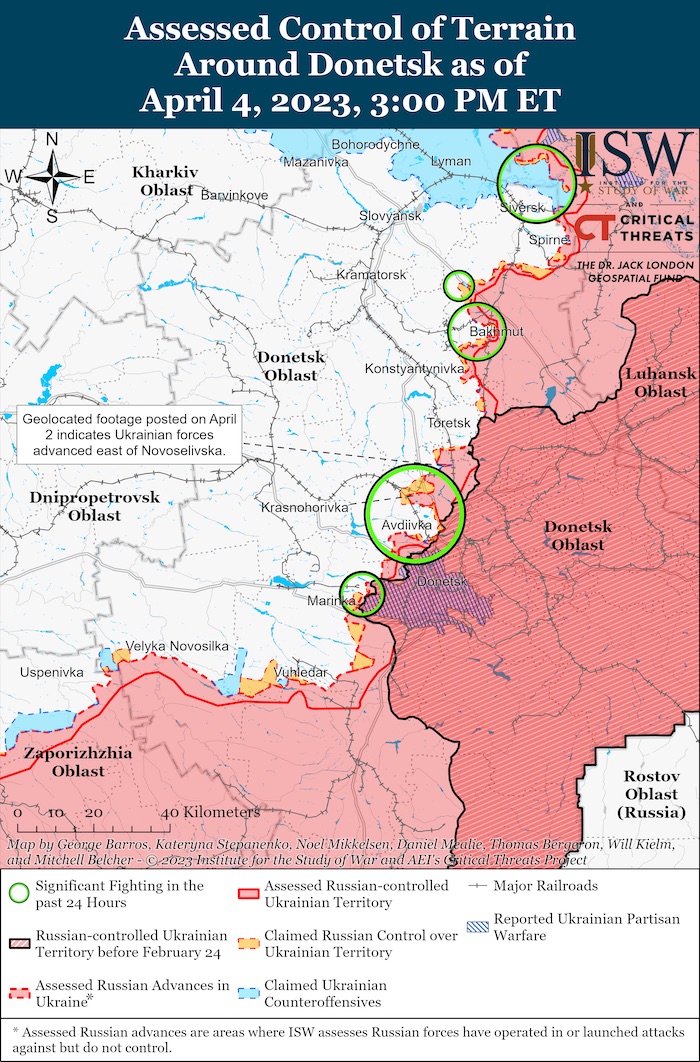
- Lyman axis: during the day, Russian forces conducted unsuccessful offensive actions in the areas south of Kreminnaya and south of Spirne (Donetsk oblast). More than 20 settlements, including Stelmakhivka, Tors’ke, Sivers’k, Rozdolivka, and Spirne (Donetsk oblast) were subject to artillery attacks.

- Bakhmut axis: Russian forces makes further attempts to seize the town of Bakhmut. The occupiers carried out unsuccessful offensive actions in the vicinities of Bohdanivka (Donetsk oblast). During the day, Ukrainian Defense Forces repelled about 30x attacks. More than 15 settlements, including Vasyukivka, Minkivka, Orihovo-Vasylivka, Novomarkovo, Bakhmut, Chasiv Yar, Hryhorivka, Ivanovs’ke, Severne, and Shumy (Donetsk oblast) suffered enemy attacks.
A timelapse of the Russian advances inside Bakhmut over the past month. pic.twitter.com/4OYBYcl99N
— War Mapper (@War_Mapper) April 5, 2023
- Avdiivka and Mariinka axes: Russian forces carried out unsuccessful offensive actions in the vicinities of Novokalynove, Severne, Pervomaiske, and Mariinka (Donetsk oblast). At the same time, Russian forces shelled Novobakhmutivka, Novokalynove, Avdiivka, Vodyane, Pervomaiske, Krasnohorivka, Heorgiivka, and Mariinka.
- Shakhtarske axis: Russian forces stays on the defensive. Russian forces made active use of UAVs to adjust artillery fire. They shelled Pobieda, Novomykhailivka, Vuhledar, Prechistivka, and Velika Novosilka (Donetsk oblast).
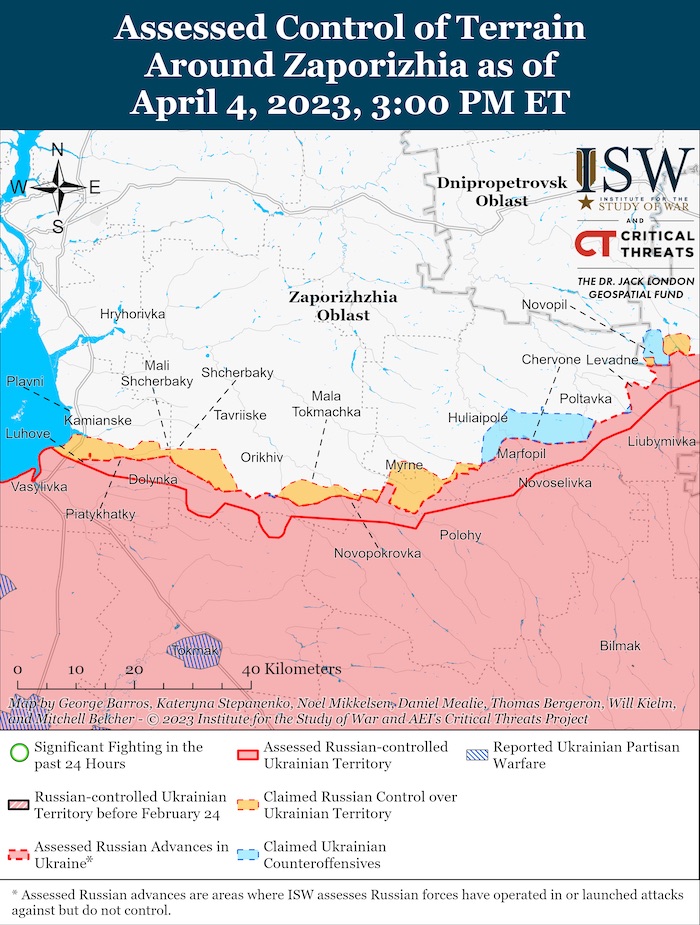
- Zaporizhzhia and Kherson axes: Russian forces continue to build up their defensive Russian forces shelled more than 30 settlements, including Novodanylivka, Orihiv, Shcherbaki, and Mali Shcherbaki (Zaporizhzhia oblast); Kachkarivka, Zmiivka, Kozats’ke, Mykolaivka, Ivanivka, and Dniprovs’ke (Kherson oblast); as well as the city of Kherson.
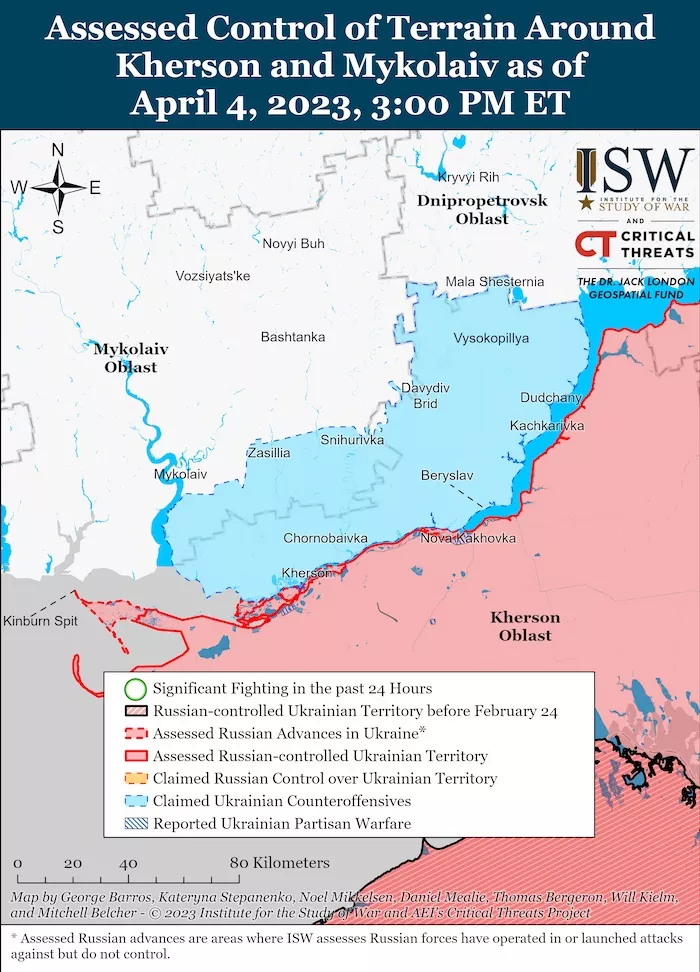
Military Updates
Ammunition shortage of Wagner Group quickly ends, Russians redouble attacks on Bakhmut, Ukrainska Pravda reports, citing Ukraine’s Special Operations Forces (SOF). “Russian forces had enough problems with ammunition, the head of Wagner was saying that they had no ammunition, so they could not continue their assaults. This was a great moment for us to raid and ambush their units. But it all ended quickly, ammunition was delivered to them, and artillery and airstrikes became twice as strong now." According to the soldier of the SOF, Russian artillery works non-stop: the shelling does not stop for a second. Drones (Russian Orlan), which track the movement of Ukrainian troops, also fly overhead, and the occupiers launch an air or artillery attack there immediately after [they spot the troops]. The occupiers are sending entire assault units to the city of Bakhmut itself. Russians suffer great losses, but new forces rush into battle to replace those killed, sometimes even during the battle. That is, the invaders use their own "as stepping stones". According to Sokil, the Wagnerites use hard drugs or some other stimulants, because, despite the landing of shells from several tens of metres away during battles, they go into battle without even ducking. There were cases when they stormed even without weapons, they simply tried to overpower with sheer numbers, Sokil describes the events. According to the soldier, one should not underestimate Russians, who also have their own "motivation", planted by powerful Russian propaganda – the destruction of Ukraine. […] The special officer notes that the situation in Bakhmut is currently the most difficult.”Ukrainian attacks on supply lines have already constrained Russian offensive operations, says Tavria front spox. Russians can't open a fifth front because logistics are already strained, and they are forced to take equipment out of Mariupol after strikeshttps://t.co/6pRtVuO3nF
— Euromaidan Press (@EuromaidanPress) April 5, 2023
Line of active hostilities in Ukraine is over 1,200 km long, Ukrinform reports, citing President Zelensky. “The line of active hostilities in Ukraine now is more than 1,200 kilometers long. It’s like from Washington, D.C., to Chicago and back! The total frontline is even more than that, Zelensky told. According to the President of Ukraine, the Kremlin dreams of humiliating America and Europe, and the whole free world, as well as of splitting NATO and provoking a conflict that will force the American nation to choose whether to fight or not. […]The Head of State noted that Ukraine is capable of preventing the expansion of the war and defeating Russia.” Russia deploys six missile carriers in the Black Sea – OC South, Ukrinform reports, citing Operational Command South. "Amid enemy aircraft activity in the southeastern sector, the naval group in the Black Sea grew to 15 warships, including as many as 6 missile carriers, 2 of which are submarines, which may indicate an extremely high threat of a missile strike, the report says. The operational command specified that the total volley of Kalibr missiles can reach 40. The operational command also added that although it is quite likely that not all missile carriers are equipped, air raid sirens should not be ignored.” https://twitter.com/EuromaidanPress/status/1643350476623159296 According to British Defence Intelligence, (last 48 hours): https://twitter.com/DefenceHQ/status/1643537322535706624Last night, 17 Russia's Iranian-made Shahed-series drones targeted Odesa, Ukrainian air defenses downed 14 of them - Air Force Command, Operational Command South
— Euromaidan Press (@EuromaidanPress) April 4, 2023
One hit an industrial facility in the city starting a fire.https://t.co/Q9i7VAMKmt
- On the 28th March 2023, Russian Prime Minister Mikhail Mishustin said that a move to issuing some of Russia’s sovereign debt in foreign currencies was ‘under development’. The move is almost certainly an indication that Russia anticipates external financial support from foreign states it deems ‘friendly’.
- Once the development is completed, investors from other countries will be able to purchase Russia’s sovereign debt and therefore finance some of Russia’s future budget shortfalls. Such investors would be indirectly financing Russia’s invasion of Ukraine.
- In recent months, Russia’s own banks have been the main entities purchasing Russian state debt. However, they are unlikely to have the capacity to fully fund anticipated future budget deficits. Russian officials likely see external debt issuance as one way to plug gaps in Russia’s finances as they plan for a long war in Ukraine. However, it remains unclear whether Russia will succeed in implementing the measures.
- Russia is likely seeking to sponsor and develop alternative private military companies (PMCs) to eventually replace the Wagner Group PMC in its significant combat role in Ukraine.
- This takes place in the context of the high-profile feud between the Russian Ministry of Defence and Wagner Group. Russia’s military leadership likely wants a replacement PMC that it has more control over. However, no other known Russian PMC currently approaches Wagner’s size or combat power.
- Russia likely sees continued utility for PMCs in Ukraine because they are less constrained by the limited pay levels and inefficiency which hamper the effectiveness of the regular army. Russia’s leadership probably believe heavy casualties amongst PMCs will be better tolerated by Russian society compared to regular military losses.
Losses of the Russian army
As of Wednesday 5 April, the approximate losses of weapons and military equipment of the Russian Armed Forces from the beginning of the invasion to the present day:- Personnel – about 176240 (+550)
- Tanks – 3629 (+2)
- Armoured combat vehicles – 7005 (+6)
- Artillery systems – 2707 (+10)
- Multiple rocket launchers –MLRS - 532 (+4)
- Air defence means – 280 (+0)
- Aircraft - 306 (+0)
- Helicopters - 291 (+0)
- Automotive technology and fuel tanks – 5573 (+11)
- Vessels/boats - 18 (+0)
- UAV operational and tactical level – 2283 (+6)
- Special equipment – 299 (+1)
- Mobile SRBM system – 4 (+0)
- Cruise missiles – 911 (+0)
Humanitarian
Almost 1,900 Ukrainian settlements need reconstruction, Ukrinform reports, citing President Zelensky. “Almost 1,900 Ukrainian cities and villages need reconstruction due to Russian armed aggression. Schools and churches, residential buildings and enterprises, transport and power plants... […] In his words, Ukraine’s reconstruction will be the largest economic project in Europe in lifetime of several generations. […] Millions of Ukrainian families are now torn by the war, millions are forced to seek protection from Russian terror in other countries. Hundreds of Ukrainian cities and villages have been burned by Russian artillery, missiles, aircraft and Iranian drones used by Russia. […] The President of Ukraine stressed that thousands of fields had been mined in the country, a significant portion of economy had been broken, and thousands of people had been forcibly deported to Russia.” Hundreds of houses flooded in Kramatorsk due to destroyed gateway, water rising, Ukrainska Pravda reports, citing Pavlo Kyrylenko, Head of the Donetsk Oblast Military Administration. “A sluice gate on a pond in the city of Kramatorsk in Donetsk Oblast has been partially destroyed, which resulted in an uncontrolled release of water. Nearly 260 private houses on 30 streets were flooded. The water level is still rising. Rescue workers from the State Emergency Service of Ukraine are working on site, same as the members of profile departments of the Donetsk Oblast State Military Administration and the Kramatorsk City Military Administration.” Shelling of Donetsk region: 6 civilians killed, 7 more injured, Ukrinform reports, citing a statement from the Prosecutor General’s Office. “On April 4, Russian forces shelled populated areas in the north of Donetsk region with missiles, artillery and Grad multiple launch rocket systems, killing six civilians and injuring seven more. Residential quarters were the epicenter of Russian strikes. During the attacks, two mine workers in Toretsk were killed: a mine dispatcher and a nurse. A shop assistant was killed in Krasnohorivka, and three men were killed in Lastochkyne village, Pokrovsk district. During the shelling of Bakhmut, Hirnyk and the village of Ocheretyne, seven civilians received injuries of varying degrees of severity. Blast waves and projectile fragments damaged an administrative building, apartment blocks, private residential houses, and farm buildings.” Canadian Red Cross transfers more than $220M to support Ukraine, Ukrinform reports. “The Canadian Red Cross has already transferred more than $220 million to support Ukraine and will continue to provide assistance.”Environmental
https://twitter.com/EuromaidanPress/status/1643360291349233665 Nuclear and radiation safety threats, as reported by EcoZagroza. “On March 25, the Russian dictator announced that the construction of a storage facility for Russian tactical nuclear weapons would be completed in Belarus by July 1. In response to this announcement, the German Ministry of Foreign Affairs stated that Russia was using nuclear intimidation and reminded about the international obligations of Belarus under several declarations to be a nuclear-weapon-free zone. Ukraine demands that the UN Security Council be convened in connection with Russia's intentions to place tactical nuclear weapons in Belarus. Since the start of the full-scale war, the terrorist country has made Ukrainian civilian nuclear facilities the central target of its military strategy. Jennifer Granholm, the US Secretary of Energy, reminded in a column for The Hill about the outrageous actions of Russian occupiers against Ukrainian nuclear facilities and called for more resolute action against Russian terrorism. Over the past year, Russia has launched a campaign that grossly disregards the basic principles of nuclear security. Such unlawful and reckless behavior of the occupiers requires the attention of the whole world and our actions. Russia seized and later looted the Chornobyl nuclear power plant, and then used the site as a foothold for its attempt to capture Kyiv. In addition, the aggressors attacked the Kharkiv Institute of Physics and Technology. In September 2022, a Russian missile damaged the buildings of the South Ukrainian nuclear power plant. On March 29, Rafael Grossi, the Director General of the International Atomic Energy Agency, arrived at the Zaporizhzhia Nuclear Power Plant. This is the second visit by the head of the IAEA to the largest nuclear plant in Europe since it was occupied by Russian forces. The visit lasted several hours. Rafael Grossi returned to the territory under Ukraine's control with experts from the Agency's Permanent Mission, who had been stationed at the Zaporizhzhia plant until the current rotation. Other representatives of the IAEA will continue to monitor the situation at the nuclear facility.” Ukraine has already received €15M from donor countries to restore Chornobyl zone, Ukrinform reports. “Ukraine has received EUR 15 million from donors for the reconstruction of the Chornobyl zone, and a total of EUR 225 million is expected to arrive from international partners. […] The official clarified that the restoration plan consisted of nine points, it was designed for EUR 225 million, although the damage from the occupation was about EUR 100 million. It is about not only restoring normal functioning, but also improving the operation of the Chornobyl Nuclear Power Plant and creating a scientific hub in the territory of the exclusion zone. The plan also provides for mine clearance operations in the entire territory, restoration of computer and office equipment, infrastructure and equipment for handling radioactive materials. According to the head of the State Agency of Ukraine on Exclusion Zone Management, as of today, it was possible to obtain EUR 15 million for these purposes. The European Commission, the EBRD, the US Department of Energy, Norway, Great Britain, and Germany are among the main donors.”Legal
Russian colonel and 2 soldiers raped a Ukrainian woman in Kharkiv Oblast, Ukrainska Pravda reports, citing the Security Service of Ukraine; Kharkiv Oblast Prosecutor’s Office, and Dumka.media. “Ukrainian law enforcement has identified three members of the Russian military who raped a young Ukrainian woman during the occupation of Kharkiv Oblast in 2022. One of them is a colonel, one a junior sergeant, and one a private. The three of them were served suspicion notices in absentia. […] Ukraine’s Security Service conducted an investigation and identified the three Russian occupiers who committed the gang rape: all of them were members of the 99th Artillery Regiment of the Russian Armed Forces. According to the evidence obtained by the Security Service, the three perpetrators were served notices of suspicion under Art 28.2 and Art 438.1 of the Criminal Code of Ukraine (violation of the laws and customs of war committed by a conspiring group of persons).” UN rights body extends Ukraine inquiry into crimes since Russia's invasion, Reuters reports. “The United Nations Human Rights Council overwhelmingly voted in favour on Tuesday of extending the mandate of an investigative body probing possible war crimes committed since Russia's invasion of Ukraine. […] The scope and brutality of Russia's atrocities in Ukraine are simply beyond any human comprehension, Ukraine's ambassador to the United Nations in Geneva, Yevheniia Filipenko, told the Council ahead of the vote. We strongly believe that the continued work of the Commission in further investigating, documenting and reporting human rights violations and international crimes committed against the people in Ukraine could save more innocent lives (and) could contribute to accountability for perpetrators and justice for victims. In a report published last month, the commission found that crimes committed by Russian forces in Ukraine, including the use of torture and attacks against the country's energy infrastructure, could constitute crimes against humanity. Russia, which refused to address the Human Rights Council on Tuesday, vigorously denies committing atrocities or targeting civilians in Ukraine. China, a Russian ally, voted against the initiative, which was backed by more than 50 states. South Africa abstained, saying the initiative could drive a "deeper wedge" between the sides. Still, observers said the number of favourable votes - just four fewer than at the inquiry's creation in March 2022 - was promising, more than a year into the war. Only two countries opposed this which is quite remarkable, said Olaf Wientzek, director of the Geneva office of the German Konrad Adenauer Foundation think tank. The commission found that some 16,000 children have been unlawfully transferred and deported from Ukraine, citing a Ukrainian government figure. Russia denies the accusation, arguing it has evacuated people voluntarily from Ukraine. Putin's war has caused dire humanitarian consequences in Ukraine, throughout Europe and around the world, and the forcible transfer and deportation of Ukraine's children is truly sickening, US Permanent Representative to council, Michèle Taylor, said. Germany's ambassador Katharina Stasch called the deportations an attempt to steal Ukraine's future.”11-year sentence for free thinking and civic activism in #Russia ‘political reprisals against the entire #CrimeanTatar people’ in occupied #Crimea #Ukraine #Vadim_Bektemirov #LetMyPeopleGo #StandWithUkraine #StopRussiahttps://t.co/B7A03U3LzO pic.twitter.com/oXEeZlF8FJ
— Euromaidan Press (@EuromaidanPress) April 4, 2023
Support
Ukraine needs F-16s due to Russia's aerial superiority - Air Force spox, Ukrinform reports, citing Yuriy Ihnat, the spokesman for the Ukrainian Air Force. “Russia outnumbers us […] by five to six times. This is the grouping that today is located at those 40 airfields around Ukraine and in occupied Crimea alone. In addition, technologically, they are several times better. They carried out deep modernization of the Su-27 aircraft, today it is the Su-30, and there is also a Su-35 variant, as well as a Su-34 fighter-bomber, and what these aircraft fire off is a new threat," Ihnat said, adding that the Russian Federation launches about 10 guided aerial bombs over Ukraine almost every day, without entering the zone protected by Ukraine’s air defenses. […] Ukraine desperately needs F-16s, which have undergone several stages of modernization, spokesman emphasized. The F-16, which is the same age as the MiG-29, has undergone several stages of deep modernization. This includes the replacement of its main equipment: it is an on-board radar that can see far and a wide range of weapons – cruise missiles, guided air missiles capable of hitting air, ground, and water surface targets – everything is there in the F-16 aircraft. That is why we need such a multi-purpose warplane. The MiG-29, which is handed over to us by our partners, doesn’t have this. There, a small modernization of the communication system, navigation system, friend-or-foe system, and that’s pretty much it. But we do understand that this is the first step, and we thank our partners for such support, spokesman emphasized. Commenting on the issue of training for Ukrainian pilots, he said that some pilots had already completed training on F-16s, but the preparation of technical documentation and engineers who would service the F-16 is no less important. The adaptation of the infrastructure of Ukrainian airfields is also critical, Ihnat said.” NATO countries to discuss readiness of Ukrainian pilots to operate F-16 jets, Ukrinform reports. “Ukrainian Foreign Affairs Minister Dmytro Kuleba has been assured by partners that NATO countries will discuss the readiness of Ukrainian pilots to operate the F-16 fighter jets. […] In particular, the head of Ukrainian diplomacy raised the issue of delivering the F-16 fighter jets to Ukraine at some bilateral meetings in Brussels. According to Kuleba, the Ukrainian side dispelled some arguments of those claiming that providing Western aircraft to Ukraine would be too long, too difficult and nearly impossible from a practical point of view. Kuleba mentioned that the information he had provided about Ukraine’s readiness to operate the F-16 fighter jets, which is much higher than some believe, would be discussed with the political leadership of NATO countries. The head of Ukrainian diplomacy expressed confidence that a decision on providing Western fighter jets to Ukraine will be endorsed, but it is a matter of time.” Kuleba on results of NATO-Ukraine Commission: AFU to receive everything needed for counteroffensive, Ukrinform reports. “At a meeting of the NATO-Ukraine Commission, partners agreed to increase financing for Ukraine’s projects and speed up the supply of certain weapons. The relevant statement was made by Ukrainian Foreign Affairs Minister Dmytro Kuleba at a briefing, following the meeting of the NATO-Ukraine Commission in Brussels. According to Kuleba, there is absolutely no weariness that some media outlets predict from time to time. Today, there have been clear not only words of support, but also the announcements of new commitments, Kuleba noted.” US allocates $2.6 billion in military aid to Ukraine, Ukrainska Pravda reports, citing European Pravda. “The US Department of Defence on Tuesday announced another package of military aid to Ukraine worth of US$2.6 billion. The package consists of two parts: the first, worth of US$2.1 billion, is funded by the Ukraine Security Assistance Initiative, under which weapons are ordered from manufacturers, rather than taken from the stockpiles of the US Armed Forces. These funds will finance additional ammunition for NASAMS systems, nine 30-mm anti-drone guns, 10 C-UAS laser-guided mobile missile systems, three air surveillance radar stations, 30-mm and 23-mm anti-aircraft munitions, 130-mm and 122-mm artillery shells, 122-mm rockets for Grad systems, multiple launcher rocket systems and ammunition for them, 120-mm and 81-mm mortar systems and mortar bombs for them, as well as 120-mm tank ammunition. Also provided are Javelin anti-tank systems, high-precision aviation munitions, approximately 3,600 small arms and more than 23 million rounds of ammunition, seven tactical vehicles for the evacuation of equipment, eight heavy fuel tankers and 105 fuel trailers, armoured bridge systems, four logistics vehicles, trucks, and ten trailers for the transportation of heavy equipment, means of secure communication, including satellite, as well as training and funds for the maintenance of the mentioned equipment. The remaining $500 million, which is primarily for munitions, will come under the President's Arms Reduction Initiative, which allows the US leader to transfer weapons from the US stockpile in emergencies. Within this package, Ukraine will receive additional ammunition for Patriot anti-aircraft missile systems and HIMARS systems, 155-mm and 105-mm artillery shells, 120-mm mortar bombs, 120-mm and 105-mm tank ammunition, 25-mm ammunition, heavy TOW anti-tank guided missiles, approximately 400 grenade launchers and 200,000 rounds for them. In addition, these funds will fund 11 tactical equipment evacuation vehicles, 61 heavy fuel tankers, 10 heavy equipment trucks and 10 trailers, vehicle maintenance and repair support equipment, as well as spare parts and other field equipment.” Norway and Denmark to deliver 8,000 artillery shells to Ukraine, Ukrinform reports. “The governments of Norway and Denmark agreed together to provide Ukraine with 8,000 artillery shells. Oslo will send 155-mm artillery shells and Copenhagen will provide appropriate fuses.” Western Allies to plan assistance to Ukraine for a longer period of time, Ukrinform reports. “Since the beginning of the year, Ukraine has received fewer new promises, with some exceptions, to supply arms, but the commitments become more long-term. This is revealed from a new Ukraine Support Tracker study prepared by the Kiel Institute of World Economics, Ukrinform reports. Compared to December 2022, there has been an overall decrease in the amount of new aid pledged to Ukraine. During the new period covered by the study, from January 16 to February 24, 2023, Ukraine received €12.96 billion, with a significant majority of these funds coming from just a few donors. For example, Japan and the Scandinavian countries promised to provide significant support to Ukraine in early 2023. The most notable are the Scandinavian countries: Norway (€1.11 billion, an increase of 90%), Sweden (€0.33 billion, plus 41%), Denmark (€0.24 billion, plus 33%), and Finland (€0.56 billion, plus 165%). Japan has pledged significant new financial assistance worth €5.1 billion in loans, and the Netherlands has pledged €2.5 billion, earmarked, among other things, for a new Patriot system for Ukraine. A new trend in aid to Ukraine is the adoption of "longer planning horizons." Previously, aid commitments were short-term and difficult to predict. Only the United States made commitments for an entire fiscal year. Now other countries, such as the United Kingdom and the Netherlands, follow this model, pledging the same amount of aid in 2023 as in 2022. Norway has even announced a multi-year program to support Ukraine with financial and military assistance worth approximately 7 billion euros over the next five years, the study concluded. The development towards one-year or multi-year plans in the Ukraine aid is to be assessed very positively. So far there has been a tangle of individual national commitments. This greatly complicated budget and military planning in Ukraine. It is gratifying that some Western governments are now going ahead and making medium-term commitments, Christoph Trebesch, leader of the team creating the Ukraine Support Tracker and research center director at IfW Kiel said. The Ukraine Support Tracker provides a list and quantitative assessment of military, financial and humanitarian assistance pledged to Ukraine since January 24, 2022 (currently through February 24, 2023). The analysis covers 40 countries, including the EU, and other G7 members, as well as Australia, South Korea, Norway, New Zealand, Switzerland, Türkiye, China, Taiwan, and India. In addition, the EU institutions are included as separate donors. The tracker lists government-level commitments; private donations or donations from international organizations such as the IMF are not included in the main database.”New Developments
Shoigu announced that Belarus now has access to assault aircraft and Iskander-M missile systems capable of delivering tactical nuclear strikes https://t.co/GPUoScnzDa
— Euromaidan Press (@EuromaidanPress) April 4, 2023
- Finland joins NATO in historic shift, Russia threatens 'counter-measures', Reuters “Finland formally joined NATO on Tuesday, its flag unfurling outside the military bloc's Brussels headquarters, in a historic policy shift brought on by Russia's invasion of Ukraine that drew a threat from Moscow of "counter-measures." Finland's accession, ending seven decades of military non-alignment, roughly doubles the length of the border the North Atlantic Treaty Organization shares with Russia and bolsters its eastern flank as the war in Ukrainegrinds on with no resolution in sight. […]
- Putin triggered 'historic' Nordic enlargement of NATO – Stoltenberg, Reuters “Russian President Vladimir Putin has achieved the opposite of his Ukraine war aims by triggering Finland's "historic" accession to NATO later on Tuesday, alliance chief Jens Stoltenberg said, declaring Sweden would also join soon. President Putin had as a declared goal of the invasion of Ukraine to get less NATO, he told reporters at NATO's Brussels headquarters, speaking hours before Finland was officially to become a member of the military alliance. He is getting exactly the opposite... Finland today, and soon also Sweden will become a full fledged member of the alliance, Stoltenberg said.”
- Russia says Finland's NATO accession is dangerous historic mistake, Reuters “Russia and Finland share a 1,300-km (800-mile) border, and Moscow has already said it will beef up military divisions stationed in its west and northwest. Defence Minister Sergei Shoigu told Russia's military leadership that Finland's accession creates the risks of a significant expansion of conflict. […]The Kremlin said Russia would be forced to take counter-measures in response to Finland's NATO entry that it would adjust depending on the kind of military deployments and infrastructure rolled out in Finland. The further expansion of NATO is an encroachment on our security and on Russia's national interests, said Kremlin spokesman Dmitry Peskov. Russia's Foreign Ministry said Finland was committing a dangerous historic mistake by joining NATO that would dilute its own influence on the world stage and hurt its ties with Moscow. Helsinki's policy of military non-alignment had long served Finnish national interests and was an important factor of confidence-building in the Baltic Sea region and the European continent as a whole, the ministry said in a statement. This is now a thing of the past.”
- NATO to put in place arrangements so that Ukraine can deter future aggression, Ukrinform reports, citing NATO Secretary General Jens Stoltenberg. “NATO Foreign Ministers meet at an important moment for our security. [Tuesday], we will hold the NATO-Ukraine Commission with Foreign Minister Kuleba. To address Russia’s war of aggression, and our support to Kyiv. We do not know when this war will end. But when it does, we will need to put in place arrangements so that Ukraine can deter future aggression. And history does not repeat itself, Stoltenberg said. In his words, NATO Allies cannot allow Russia to continue to chip away at European security. I welcome President Zelensky’s peace plan, which upholds the principles at the heart of the UN Charter. It provides the foundation for a just and sustainable peace. But there are no signs that President Putin is preparing for peace. He is preparing for more war. That is why we are united in our determination to stay the course.”
- Macron and Biden want to engage China to end war in Ukraine, Elysee says, Reuters “French President Emmanuel Macron and US President Joe Biden agreed in a telephone call ahead of a visit to Beijing by Macron to engage China to hasten the end of the war in Ukraine, the Elysee Palace said on Wednesday.”
- Sudden army combat readiness check begins in Belarus, Ukrainska Pravda reports, citing the Ministry of Defence of Belarus. “Alexander Lukashenko, the self-proclaimed President of Belarus, has ordered a combat readiness check of the Armed Forces of Belarus. The measures are complex and are set to determine the command’s capability to control subordinate military units and subunits while they are on high alert, and the readiness of military units to complete tasks as directed in due time. During this "check", military equipment will be moving across Belarus, and there may be a temporary traffic restriction for civilian vehicles on public roads and terrain areas.”
- Lukashenko meets Russia's chief intelligence officer, says Belarus faces "inconceivable" threats, Ukrainska Pravda reports, citing Lukashenko-aligned Telegram channel Pul pervogo and TASS. "In light of the recent events – and countering terrorism is a prominent reason. The Russian Federation's special military operation [Russian euphemism for the war in Ukraine - ed.] is an operation that has forced us to consider all security structures from all sides. As I often say, if it hadn’t happened, we would have had to come up with something to spur us on. In light of all this, we have started taking active measures. But the threats are very serious. At times inconceivable."
- Putin and Lukashenko to meet in Moscow on April 5-6 – Kremlin, Reuters “Belarus' President Alexander Lukashenko will travel to Moscow on Wednesday for two days of talks with Russian President Vladimir Putin, the Kremlin said. Kremlin spokesman Dmitry Peskov said last week the two leaders would discuss Lukashenko's call for an immediate ceasefirein Ukraine at an upcoming face-to-face meeting. Putin and Lukashenko will hold talks on topical bilateral and international issues on April 5, before a meeting of the Supreme Council of the Union State on April 6, the Kremlin said in an announcement published on Tuesday.”
Assessment
https://www.understandingwar.org/backgrounder/russian-offensive-campaign-assessment-april-4-2023*- On the war.
The Institute for the Study of War has made the following assessment as of April 4, 2022:
- The Kremlin will likely attempt to coerce Belarus into further Union State integration when Russian President Vladimir Putin and Belarusian President Alexander Lukashenko meet in Moscow on April 5 and 6.
- The Kremlin continues to attempt to employ nuclear threats to deter Western military aid provisions to Ukraine ahead of Ukraine’s planned counteroffensive.
- Wagner Group financier Yevgeny Prigozhin’s demonstrative response to the assassination of Russian milblogger Maxim Fomin indicates that Prigozhin likely believes that the attack was in part directed at himself.
- The Kremlin continues to attempt to (falsely) reassure the Russian public that the war in Ukraine will not have significant long-term economic consequences.
- The Kremlin is likely trying to shift more responsibility for growing Russian industry onto regional bodies to insulate itself from possible criticism about Russia’s deteriorating economic situation.
- Russian forces conducted limited ground attacks along the Svatove-Kreminna line.
- Russian forces continued offensive operations in and around Bakhmut, and along the Avdiivka-Donetsk City frontline.
- Russian forces continue to prepare for a rumored pending Ukrainian counteroffensive in the southern direction.
- Russian Defense Minister Sergei Shoigu claimed that Russia’s ongoing spring conscription cycle is going according to plan, progressing as quickly as planned, and has completed initial military registration.
- Russian occupation officials denied Ukrainian reports that Russian occupation authorities are preparing evacuation plans from occupied regions of Ukraine.
- Consequences and what to do?




